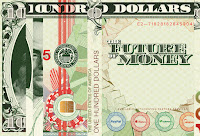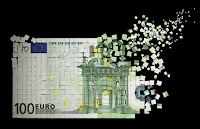A nickel ain’t worth a dime anymore.
Yogi Berra
The concept of money
dates back to the beginning of civilization.
Coins were stamped to certify that they contained the required weight, making
trade trustworthy, even among strangers.
Money was a very efficient way to transact business, much better
than bartering, or keeping track by notches on a stick. It was also a useful
store of wealth, certainly more convenient than livestock or grains.
These two core functions – medium of exchange and supply of value – still
define money today. (1)
Fiat Money
In 1944, most countries tied their currency exchange rate to
the US dollar, which was itself pegged to gold. When the US went off
the gold standard in
1971, all currencies essentially became fiat money; this meant that the value was derived from the
governments that issued them rather than from commodities.
With fiat money, a
country can increase or decrease its money supply at will, which gives it enormous
control over its own economy. If the value is too low, it can cause hyperinflation;
if it is too high, it limits export.
Black Money
Unreported cash, or “under-the-table”
transactions are common in some countries. In India, “black money” is outlawed,
but is still widespread. Paying for a home, or any large purchase, is often at
least party “black” – the reported price is an acceptable taxable valuation; in
addition, extra, off-the-books cash money is offered as additional inducement. (2)
The total amount of black money deposited in foreign banks remains
unknown. Some reports claim that black-money stashed by Indians in Switzerland
exceeds US $12 trillion, while Swiss Banks themselves claim that it is “only
about US $2 billion.”
In the US, a 2011 study concluded that around 20% of total
reportable income is either not reported or not properly reported – this was about
a half a trillion dollars in 2008.
End of Cash
Cash is expensive to produce and maintain. Studies show that
maintaining the US cash systems – printing new bills, recycling old ones,
moving stacks of cash in armored trucks, replenishing ATM machines – costs about
1% of GDP. The marginal cost of a cash transaction is about double that of a
debit-card transaction. (3)
The indirect costs of cash are substantial. A 2011 US study
found that about a fifth of total reportable income – about U $500 billion – is
hidden from tax reporting. In 2008, it
was estimated that secret offshore bank accounts were responsible for about 20%
of the tax gap, which suggests that the remaining 80% can be attributed to
unreported cash.
The need to move beyond cash has been recognized in many smaller
countries. In the Netherlands, some shopping centers are completely cash free. In
Sweden, the government and labor unions are cooperating to reduce the amount of
cash in circulation because cash is the usual target of robberies.
Credit Cards
 Cash is going out of
style. For most people, it has become a small but unavoidable necessity. Established
alternatives include checks and charge cards: credit or debit.
Cash is going out of
style. For most people, it has become a small but unavoidable necessity. Established
alternatives include checks and charge cards: credit or debit. Credit-card authorization via the magnetic-stripe card was developed in the ’70s and was in wide use by the ’90s. In 2011, 6 billion magnetic-strip bankcards around the world went through card readers some 50 billion times. (4)
Most cards contain a mag stripe that is scanned for
identification. In Europe and some other regions the mag-stripe card has been
fully eclipsed by the smart card which has a microchip embedded to track
activity. About 85% of transactions can be authorized just from the information
stored on the chip. Smart cards can also have a hidden PIN for personal
identification, entered by the user without being revealed to the equipment
reading the card, which is a big improvement in security.
End of Credit Cards
In Europe, ATM theft from skimming and other fraud added up
to €23 million in the second half of 2010. In the US, where simple and
relatively insecure mag-stripe cards still predominate, ATM fraud and theft is
generally assumed to be a far larger problem – at least $1 billion every year.
The end is near for common mag-stripe cards, and even the
chip-based credit card. Emerging smartphone-based pay schemes are now
starting to catch on and will eventually eclipse the old charge card. Soon
people will be able to touch some soft keys on their cellphone to buy something
– no credit card needed. This type of completely electronic transaction will
steadily shrink the use of cash.
Biometrics
The most ambitious and failsafe identification uses Biometrics
– viewing the delicate lattice of branching blood vessels unique to each person,
just like fingerprints. Customers can simply flash a hand near the sensor. (5)
Hitachi and Fujitsu have been working for years to
commercialize biometric identification by individual vein configurations. The
technology has been tested at 80,000 ATMs in Japan and is working so well that
it is expected to move into widespread use relatively quickly.
Technology is transforming the nature of transactions and
altering the way we interact with the vast, churning digital economy that
already pervades. Finally, in theory at least, the new digital money cannot be
counterfeited.
Mobile Phones – the
Ultimate Currency Exchange
The ubiquitous mobile phone is an enabling technology, an attractive
alternative to cash. Beyond credit card authorization in business, the mobile
phone makes it easy for people to pay each other. (6)
Within a few years all over the world, the mobile phone
will be taking over and will change money forever. Switching among dollars and
euros and frequent-flier miles and Facebook Credits and Google Bucks and any
other form of money will be just a matter of choosing from a menu on a phone.
The cost of introducing new currencies will collapse. The
future of money won’t be the science-fiction idea of a single galactic currency,
but the ability to switch between and use hundreds or thousands or even
millions of currencies.
Bank Transformation
Clearly, the global financial system must be based on more
than just manipulation by a small group of central bankers. After centuries of
dominance, most banks recognize that they have to change. (7) (8)
Until recently, the banking
industry enjoyed comfortably stable revenues. They toyed with new technologies
and social trends without really developing a clear strategy around how to
harness them. Today, however, banking is undergoing an unprecedented revolution
that’s being spurred on by technology. The recent worldwide economic instability
and the inexorable rise of the smartphone will force banks steadily to develop innovative
strategies and implement different tactics.
Virtual Currency –
Bitcoin
This discussion of money is not complete without at least a
brief discussion of Bitcoin. This electronic-cash system concept was introduced
in a 2008 paper by a developer known only as "Satoshi Nakamoto". (9)
Servers, called bitcoin “miners” process and confirm transactions
after adding them to a ledger. The ledger is updated and archived periodically
using peer-to-peer file sharing. Each new ledger update creates some newly
minted bitcoins. The number of new bitcoins created in each update is halved
every 4 years until the year 2140 when this number will round down to zero. At
that time no more bitcoins will be added into circulation and the total number
of bitcoins will have reached a maximum of 21 million bitcoins. To accommodate
this limit, each bitcoin is subdivided down to eight decimal places, forming
100 million smaller units called satoshis.
Bitcoin is open-source; its design is public; nobody owns or
controls it and everyone can take part. Bitcoins can be transferred through a
computer or smartphone without any intermediate financial institution. It has a
fluctuating value linked in part to scarcity that is mathematically
predetermined. Unlike other forms of digital cash, Bitcoin is truly untraceable
and therefore, like cash, cannot be recovered if lost or destroyed. (10)
Bitcoin is a “crypto currency”, not backed by any government.
Unlike traditional currencies where central banks decide how much money to
print, no central authority governs the supply of bitcoins. It is not backed by
physical assets, is not run by any person or group, and its value depends on
people's confidence in the currency. The current price of one bitcoin is $237;
it went as high as $ 979 in November 2013, compared to about $12 in 2012. The
market remains highly volatile. (11)
A small but growing number of stores, travel agents and
online merchants are starting to accept this digital currency as a means of
payment. One couple recently traveled the world using only bitcoins.
Bitcoin has a credible future as an alternative to
traditional payment methods. Momentum is coming from around the world, as
investors, venture capitalists and technology enthusiasts keep pumping money
into bitcoin-related businesses. The volume of transactions remains tiny, but
some think bitcoins could eventually become as omnipresent as email. (12)
Let’s Engage
- Do you use cash? Do you
always carry at least some cash?
- Do you pay your bills on
line? Do you still write checks to pay bills? Why?
- How many credit cards do
you carry in your wallet?
- Do you always carry a
smart-phone? Do you use it to pay? Would you like to?
- Do you own, or are you
interested in buying Bitcoins?
..ooOOoo..
References:
- A Special Report on the Future of Money: http://goo.gl/Uih4vd
- Indian Black Money: http://goo.gl/NWVcly
- The Beginning of The End of Cash: http://goo.gl/wirNze
- The Long Life and Imminent Death of the Mag-Stripe Card: http://goo.gl/zb9dyi
- The Biometric Wallet: http://goo.gl/igsJ4C
- There’s No Stopping the Rise of E-Money: http://goo.gl/FVyP3h
- A glimpse into the future of money: http://goo.gl/XAlYnc
- Three Wild Concepts for the Future of Money: http://goo.gl/rm2yzQ
- Future of money: Cashless, Cardless, Paperless: http://goo.gl/W4nIKa
- The Bitcoin website: https://goo.gl/yk3mFl
- Wired: The Rise and Fall of Bitcoin: http://goo.gl/1rSBmW
- Mauldin – Video on Why Bitcoin Matters: http://goo.gl/XzC0eI
Jim Pinto
Carlsbad, CA.
USA
27 May 2015
























